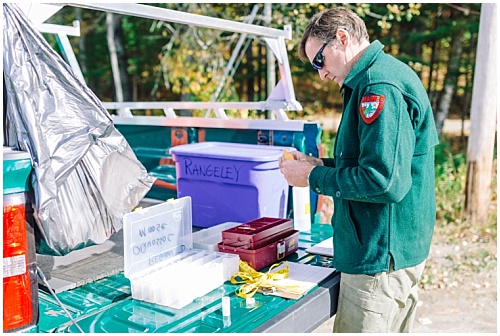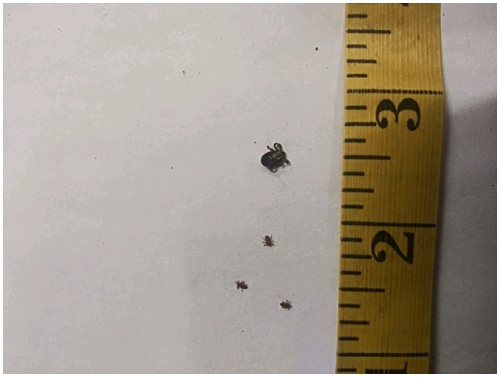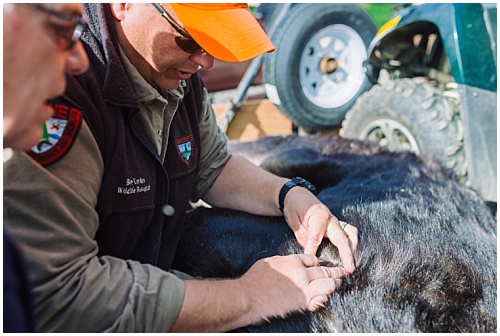October 30, 2020 at 2:43 pm
While leaf peepers are out in the masses from late September to late October, so are moose hunters. 3,135 permits were allocated for the Maine moose hunt this year, each one requiring a drawn permit and specific zone to harvest from. After years of data collection, MDIFW has found the most innovative technologies and techniques to assess the health and ecological relationships for Maine’s moose population to fine-tune management decisions.
As a few bystanders linger, moose after moose comes rolling into the Kokadjo Trading Post to be registered. This is just one of ten moose check stations across the state where biologists collect data. Many folks are spectators, driving endlessly through Maine’s beautiful woods to gawk at the foliage. Most are also attempting to find moose, some for their very first time, and when seeing a live moose fails, they turn to tagging stations. While weighing a harvested moose is often exciting for people, measurements of physical characteristics of a harvested moose provides an opportunity to assess changes in trends over time in regard to the relative health of a moose population.

Working as a team makes for a more efficient method of data collection. While one biologist speaks with the permit holder, they will check the license, mark the location of the harvest, and provide a seal number, making the moose a legal harvest. In the meantime, a second biologist begins taking measurements and collecting data the Department would not have without a managed moose hunt:
- Antler size, weight, and tooth collection: Biologists record antler measurements such as the number of points, antler spread, and type of antler. Antler size can be a reflection of foraging availability, quantity, and quality, though it’s a better representation in yearling males than older adults. While antler and body size can also provide some insight to the age of a moose, counting the number of growth layers (annuli) in the cementum of teeth, like counting rings in a tree trunk, provides the most accurate method of aging a moose, so a canine tooth is removed and analyzed at the MDIFW office in Bangor.
- Ovary collection: The last week of October is a cow (female moose) hunt, fulfilling a unique role of biological data collection from harvest, the ovaries. When brought to the tagging station, hunters must submit the ovaries, allowing biologists to analyze ovulation rates from corpora lutea counts. This provides an assessment of relative moose productivity by counting the number of hormone-filled masses that are created when an egg is released from the ovary. That reproductive data reflects the physical condition of the herd and gives a clearer image of whether the habitat is ideal enough to support the herd, and also reflects the impact of winter ticks on pregnant adult females (reducing productivity). Idyllic management of moose is dependent in part on age-specific data on body condition, giving birth, and mortality. Thus, age and size offer insight into the likelihood of a female reproducing and whether she has a single calf or twins, providing a projection of the population’s stability. Ideally, mortality balancing with births.

- Winter tick count: Further complicating assessment of moose population health and coming to the forefront of everyone’s questions, is the winter tick, often called the moose tick. The fall is the time of year when winter ticks are questing, or searching, for a host. While they exist by the millions, they are smaller than a grain of rice. So, while many hunters express their excitement by the lack of ticks on their harvested moose, it is really just a disguise of size. These successful parasites have hitched a ride on a moose before it is too cold for them to survive, and once on a host, the constant supply of blood gives them warmth and food all winter long. Though the Department has collected data on moose disease dating back to the 1960s, winter tick had not appeared to significantly impact moose until the 1990s. Since then, reports of dead moose, especially overwintering calves (calves less than one-year-old experiencing the first winter), increased in frequency. Evaluating tick load on harvested moose allow biologists a peek into tick loads and understanding how this will affect the dynamics and future conservation of moose. Biologists assess and count four areas of the harvested moose; two areas that ticks that harbor many ticks, and two areas with fewer ticks. Counting 16 transects on each moose gives MDIFW Moose Biologists Lee Kantar an idea of the early winter tick load to Maine’s moose.

While many may think that decreasing hunting pressure on the moose population would allow for more moose to survive, that unfortunately is not the case. Winter tick is not just a problem in Maine, but a problem in the Northern Hemisphere. Numerous studies have been attempted over the years in hopes of addressing the issue of winter tick loads and their impact on cervids (the deer family). While some have provided feed with tick deterrent, offered ideas of tick collars, or burning the leaf litter across the forest, these solutions are impractical, stressful on the animal, and do not work (click here to learn why these practices do not work). Universally, the most consistent and proven method of controlling the winter tick population is to reduce access to the host. In order to reduce their host, increased hunting is encouraged. While lowering the moose population may seem counterproductive, lowering population densities actually lowers the chances of ticks successfully finding a host and continuing to proliferate. To determine if moose density reduction can solve the winter tick problem in Maine, MDIFW is currently conducting a multi-phase adaptive management study in a 2,000-acre management zone in the northwestern part of the state (Zone 4).
Compiling biological data collected from tagging stations in addition to seasonal research performed year-round, Maine’s moose are closely monitored. Management decisions are influenced by the ecological and biological data collected such as composition, age structure, and reproductive rates, and applied to decisions made on the number and location of permits for each individual year. Maine’s moose population size is a direct reflection of the successful research and monitoring accomplished year after year. Moving forward, MDIFW’s goal is to keep the moose population at an appropriate capacity, where the environment can sustain the herd, providing quality, and ample foraging and reducing the number of parasites and diseases spreading between individuals.
To continue learning more about Maine’s ongoing moose study, winter tick, and Maine’s moose population, visit mefishwildlife.com/wintertick.
Read other blogs about Maine’s moose: